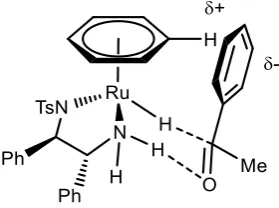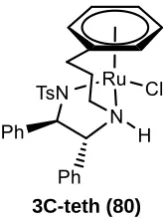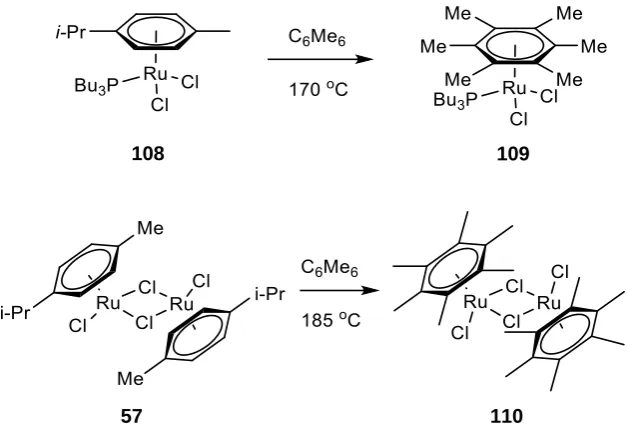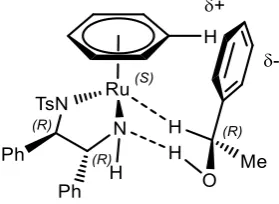warwick.ac.uk/lib-publications
A Thesis Submitted for the Degree of PhD at the University of Warwick
Permanent WRAP URL:
http://wrap.warwick.ac.uk/110795
Copyright and reuse:
This thesis is made available online and is protected by original copyright.
Please scroll down to view the document itself.
Please refer to the repository record for this item for information to help you to cite it.
Our policy information is available from the repository home page.
Applications of Tethered
Asymmetric Hydrogenation
Catalysts
By
Thomas Howard Hall
A thesis submitted in partial fulfilment of the requirements
for the degree of
Doctor of Philosophy in Chemistry
University of Warwick, Department of Chemistry
ii
Table of Contents
TABLE OF CONTENTS ... II
ABBREVIATIONS ... IV
ACKNOWLEDGEMENTS ... 1
DECLARATION ... 2
ABSTRACT ... 3
1 INTRODUCTION ... 4
1.1 CHIRALITY AND ASYMMETRIC SYNTHESIS ... 4
1.1.1 Chirality in Nature ... 4
1.1.2 Distinguishing Enantiomers ... 5
1.1.3 Mixtures of Enantiomers ... 6
1.1.4 Separation of Enantiomers ... 7
1.1.5 Preparation of single Enantiomers ... 10
1.1.6 Summary ... 12
1.2 ASYMMETRIC CATALYSIS ... 13
1.2.1 Features of a Good Asymmetric Catalyst. ... 15
1.2.2 Catalytic Hydrogenation. ... 15
1.2.3 Asymmetric Hydrogenation ... 16
1.2.4 Transfer Hydrogenation. ... 18
1.2.5 Summary ... 19
1.3 RU(II)CATALYSIS OF AH AND ATH ... 20
1.3.1 Asymmetric Hydrogenation with Ruthenium Catalysts ... 20
1.3.2 Application to Asymmetric Transfer Hydrogenation. ... 25
1.3.3 Catalyst Mechanism and Structure ... 26
1.3.4 Tethered Ru ATH Catalysts. ... 32
1.3.5 Further Tethered Ru ATH Catalysts ... 36
1.3.6 Summary ... 43
1.4 SUBSTRATES FOR ATH ... 44
1.4.1 Electron Rich Ketones ... 47
1.4.2 α,β-Unsaturated Ketones ... 58
1.5 IMPROVING ON RU(II)CATALYSIS ... 70
1.5.1 Polymer-Supported Catalysts ... 70
1.5.2 Non-Organic Solvents ... 77
1.5.3 Rh and Ir Cp* Complexes ... 80
1.6 SUMMARY ... 83
2 RESULTS AND DISCUSSION... 85
2.1 SYNTHETIC APPROACHES TO SUPPORTED OR FUNCTIONALISED CATALYSTS ... 85
2.1.1 Maleimide Catalyst. ... 85
2.1.2 Ring-Opening Metathesis Polymerisation ... 89
2.1.3 Cross-Coupling Strategy ... 92
2.1.4 Chapter Summary ... 97
2.2 OPTIMISATION OF ARENE EXCHANGE METHODS ... 98
2.2.1 Synthetic Preparation of Ligand and Metal Source ... 98
2.2.2 Arene Exchange Reaction ... 100
2.2.3 Chapter Summary ... 109
2.3 ATH OF ELECTRON RICH KETONES: ... 110
iii
2.3.2 Conformational Calculations ... 111
2.3.3 Meta-Substituted Ketones: ... 114
2.3.4 Aqueous Reductions of meta-Substituted Ketones ... 115
2.3.5 Increasing ortho-Substituent Size: ... 116
2.3.6 Other O-Substituted Ketones ... 117
2.3.7 Nitrogen Substituted Compounds ... 118
2.3.8 Chapter Summary ... 121
2.4 ATH OF Α,Β-UNSATURATED KETONES. ... 123
2.4.1 ATH of β-chloro ketones ... 123
2.4.2 ATH of Chalcone: Optimisation of 1,4- Reduction Conditions ... 126
2.4.3 ATH of Para-Substituted Chalcones: ... 133
2.4.4 Computational Calculations ... 135
2.4.5 Alkyl Substituted Enones ... 140
2.4.6 Further Variants ... 143
2.4.7 Chapter Summary ... 154
3 CONCLUSIONS AND FUTURE WORK ... 155
3.1 SUPPORTED AND FUNCTIONALISED COMPLEXES ... 155
3.2 APPLICATIONS OF TETHERED CATALYSTS ... 156
3.2.1 Mechanism of Reduction in FA/TEA ... 156
3.2.2 Selectivity in Reduction of ortho- Substituted Ketones ... 158
3.2.3 Selectivity in Reduction of α,β-Unsaturated Ketones ... 160
4 EXPERIMENTAL ... 163
4.1 GENERAL EXPERIMENTAL ... 163
4.2 PREPARATION OF COMPOUNDS,ARENE EXCHANGE: ... 164
4.2.1 OMe-Tethered Complex: Preparation of Materials ... 164
4.2.2 OMe-Tethered Complex: Arene Exchange Optimisation ... 168
4.3 PREPARATION OF COMPOUNDS,SUPPORTED CATALYSTS: ... 169
4.3.1 Untethered Ips Complex ... 169
4.3.2 3C-Tethered Ips Complex ... 173
4.3.3 OMe-Tethered Ips Complex ... 176
4.3.4 N-TsDPEN furan maleimide adducts... 178
4.4 PREPARATION OF COMPOUNDS,ELECTRON RICH KETONES: ... 185
4.4.1 Formic Acid and Aqueous Reductions ... 185
4.4.2 Ortho-Substituted ketones ... 191
4.4.3 Other Ketones ... 197
4.5 PREPARATION OF COMPOUNDS, Α,Β-UNSATURATED KETONES: ... 198
4.5.1 β-Chloro Ketones ... 198
4.5.2 Chalcones ... 200
4.5.3 Para-Substituted Chalcones ... 203
4.5.4 Alkyl Substituted Enones ... 210
4.5.5 Structure variants ... 216
4.6 ELECTRONIC STRUCTURE CALCULATIONS ... 229
iv
Abbreviations
[M+X]+ Mass spectrometry ion adduct
[α]DT Specific rotation
3Å MS 3 angstrom molecular sieves 4Å MS 4 angstrom molecular sieves Å Angstrom
ACE Angiotensin converting enzyme
AH Asymmetric Hydrogenation
API Active Pharmaceutical Ingredient
Ar Aromatic Group, generic indicator (NOT argon)
ATH Asymmetric Transfer Hydrogenation
BINAP 2,2'-bis(diphenylphosphino)-1,1'-binaphthalene
br. broad peak
CAM Cerium ammonium molybdate
CAT Catalyst
CBS Corey-Bakshi-Shibata
cc-pVTZ Correlation consistent basis set as described by Dunning.1
CH Catalytic Hydrogenation
CIP Cahn-Ingold-Prelog
conv Conversion
Cp* pentamethylcyclopentadienyl
d doublet
DCC N,N'-Dicyclohexylcarbodiimide
DCM Dichloromethane
dd doublet of doublets
DFADH Pseudomonas fluorescens Alcohol Dehydrogenase
DFT Density Functional Theory
DiPAMP Ethane-1,2-diylbis[(2-methoxyphenyl)phenylphosphine]
DKR Dynamic Kinetic Resolution
DMAPEN N1,N1-dimethyl-2-phenylethane-1,2-diamine
DMF N,N-dimethylformamide
DMSO Dimethylsulfoxide
DPEN 1,2-diphenylethane-1,2-diamine
dq doublet of quartets
dt doublet of triplets
ee Enantiomeric Excess
eq Equivalent
er Enantiomeric ratio
ESI Electrospray Ionisation Et Ethyl
EWG Electron withdrawing group
FA/TEA Formic Acid/Triethylamine (5:2 azeotrope)
GC Gas Chromatography
GC Gas Chromatography
v
HF Hartree-Fock
HMB Hexamethylbenzene
HMBC Heteronuclear multiple-bond correlation spectroscopy HMQC Heteronuclear multiple quantum coherence
HPLC High performance liquid chromatography HSQC Heteronuclear single quantum coherence
HWE Horner-Wadsworth-Emmons
IL Ionic Liquid
IPA Isopropanol
Ips para-iodosulfonyl
KIE Kinetic Isotope Effect
KR Kinetic Resolution
LCMS Liquid chromatography-mass spectrometry
maug- Minimally augmented basis set as described by Truhlar2
MCM-41 Mobil Composition of Matter No. 41 Mp melting point
MPN Nth Order Møller–Plesset perturbation theory
MPV Meerwein-Ponndorf-Verley
MPW1B95 DFT method as described by Zhao and Truhlar.3
MS Mass Spectrometry
MS Mass spectrometry
NAD+ Nicotinamide adenine dinucleotide, oxidised form
NMR Nuclear Magnetic Resonance
NSAID Non-steroidal anti-inflammatory drug
o- Ortho-substituted
p- Para-substituted
PEG Polyethylene glycol
Pet ether 40-60°C petroleum ether Ph phenyl
q quartet
R Any hydrocarbon group
R/S Cahn-Ingold-Prelog notation for enantiomers
RBF Round bottom flask
ROMP Ring Opening Metathesis Polymerisation rt Room temperature
s singlet
S/C Substrate : Catalyst ratio
t Time
T Temperature
t triplet
TBAF Tetra-n-butylammonium fluoride
tBu tert-butyl
td triplet of doublets
TH Transfer Hydrogenation
THF Tetrahydrofuran
vi TMS Trimethylsilyl (group)or Tetramethylsilane (substance)
ToF Time of flight
TON Turnover Number
Ts tosyl
TsDPEN N-(2-amino-1,2-diphenylethyl)-4-methylbenzenesulfonamide TsDPEN N-Tosyl 1,2-Diphenyl-1,2-ethylenediamine
X Any halide
δC Carbon chemical shift
ΔG Gibbs free energy change
δH Proton chemical shift
ΔH Enthalpy change
λ Wavelength
1
Acknowledgements
Firstly I would like to thank Prof Martin Wills, for the funding and support, many hours of
discussion and debate and for giving me the opportunity to undertake this project.
I would also like to thank the rest of the Wills group for their support. Especially Rina Soni for
her direct supervision of my practical work when I first began, and for teaching me many of
the tricks of the trade, and to Thomas Brown for somehow putting up with my continual
questioning for over three years.
But also the other group members I have worked with without whom the lab could not exist
and I could not have learned anywhere near as much; in particular Alessandro Del Grosso,
Roy Hodgkinson and Katherine Jolley have taught me a huge amount. Finally my MChem
students, Michael Chu, Ben Mitchell and Ben Treloar have again helped me learn in a
different way and provided excellent company and moral support.
Within the department I must thank Guy Clarkson for his outstanding crystallography. Ivan
Prokes, Robert Perry and Edward Tunnah for assistance with NMR spectroscopy and Phill
Aston and Lijang Song for their help with Mass Spectrometry. Also David Fox and Vas Stavros,
for their personal advice and guidance during the later stages of the project.
I would like to thank the EPSRC for the funding to complete this PhD.
Outside of the department, the staff at Warwick Sport and the members of the University of
Warwick Archery club, who have been with me every step of the way through my degree
experience. They have enriched my time at Warwick and given me a sense of meaning and
confidence I will never forget.
Finally to my family for supporting me at every step, and to Emma, without whom I probably
2
Declaration
The work described in this thesis is solely that of the author unless otherwise specified. The
research was carried out at the Department of Chemistry, University of Warwick between
October 2013 and March 2017. It has not previously been submitted for a degree.
Some of this work has been published previously in the following scientific journals:
1 R. Soni, T. H. Hall, B. P. Mitchell, M. R. Owen and M. Wills, J. Org. Chem., 2015,
80, 6784–6793.
2 R. Soni, K. E. Jolley, S. Gosiewska, G. J. Clarkson, Z. Fang, T. H. Hall, B. N. Treloar, R. C. Knighton and M. Wills, Organometallics, 2018, 37, 48–64.
The work presented (including data generated and data analysis) was carried out by the
author except in the cases outlined below:
1 Section 2.3.7: Nitrogen Substituted Compounds:
3
Abstract
Attempts have been made to prepare new polymer supported and maleimide functionalised ruthenium catalysts for asymmetric transfer hydrogenation. Synthetic approaches were found to be challenging but did lead to the development of a series of complexes containing
the para-Iodobenzenesulfonyl group, which may potentially serve as a handle for future functionalisation.
The arene exchange route to tethered complexes as previously published by Wills et. al. has been refined in an attempt to improve reliability. The practical challenges of carrying out the reaction and especially purifying the resulting complexes are discussed and the use of
molecular sieves as a trap for free hydrogen chloride gas is recommended.
Known tethered complexes reported by Wills have been applied to the reduction of electron rich ketones, containing oxygen or nitrogen substituents on their aromatic rings. Such ketones are relatively unreactive and require higher temperatures and extended reaction times, however in most cases the chiral alcohols could still be obtained with good yield and
enantioselectivity. The choice of solvent/hydrogen donor is shown to be important and substrate dependant.
.
Finally, reduction of β-chloropropiophenone to the dehalogenated chiral alcohol prompted an investigation into the reductions of enones with tethered catalysts. Selectivity between 1,4- and 1,2- reduction products is shown to be strongly substrate dependant but can also
4
1
Introduction
1.1
Chirality and Asymmetric Synthesis
A chiral object is one that cannot be superimposed upon its own mirror image, such as a
human hand. An achiral object has at least one plane of symmetry such that its mirror images
are superimposable. Indeed chiral objects are often referred to as right or left handed to
distinguish the otherwise identical mirror images.
The most common form of chirality in organic chemistry is a chiral centre, an atom bound to
four different atoms or functional groups. One chiral centre gives rise to two possible
mirror-image isomers, known as enantiomers. These may be identified using the Cahn-Ingold-Prelog
(CIP) notation which is based on the relative priority of functional groups arranged around
the chiral centre, as illustrated in Figure 1.4,5
Figure 1: (R) and (S) enantiomers of salbutamol, a common asthma drug. CIP numbering shown.
1.1.1
Chirality in Nature
Chiral molecules are ubiquitous in nature; proteins, carbohydrates and DNA are all
constructed from chiral building blocks such as those shown in Figure 2. Naturally occurring
amino acids such as 2 exist in the L-configuration, and this means that the enzymes and
receptors they form are all also chiral and of a single handedness in themselves. The chiral 5
membered sugar in nucleosides such as 3 contributes to the highly organised overall
structure of DNA.
5 Figure 2: Chemical structures of chiral natural building blocks L-Leucine and
Deoxyadenosine.*
Binding sites in natural macromolecular structures formed from such chiral building blocks
will interact optimally only with the correct configuration of substrate, in the same way that
a left hand fits well only in a left handed glove. As a result pharmaceutical and agricultural
chemicals generally need to be produced as one specific enantiomer. For example,
(S,S)-ethambutol 4 is an inexpensive drug for tuberculosis included on the World Health
Organisation’s list of essential medicines, while its enantiomer (R,R)-4 is both 200 times less
active and may cause blindness.6,7
Figure 3: Structure of (S,S)-ethambutol
1.1.2
Distinguishing Enantiomers
Enantiomers consist of exactly the same set of atoms with identical connectivity, and as such
have identical physical and chemical properties. However they can be distinguished by their
interaction with plane polarised light traveling through a solution, which can be measured
using a polarimeter. For each pair of enantiomeric molecules, one enantiomer will rotate the
plane of polarisation clockwise (+), while the other will rotate the plane by the same amount
anticlockwise (-). Equation 1 shows the equation for the calculation of specific rotation.
*D and L-configuration is an antiquated notation still in common use for saccharides and amino acids
that refers to a compounds relative stereochemistry compared to L-Glyceraldehyde.4
3 2
6
[𝛼]𝜆𝑇 = 𝛼 𝑙𝑐
Equation 1: Calculation of specific rotation from measured optical rotation. α = optical rotation, l= path length in dm, c=concentration in g cm-3. T = temperature in °C, λ =
wavelength of plane polarised light.
A molecule with n chiral centres may have up to 2 (n-1) distinguishable pairs of enantiomers,
in which the relative configurations of chiral centres differ between each of these pairs.
These pairs of stereoisomers are known as diastereomers and owing to their varied
structures these may differ in their chemical and physical properties in much the same way
[image:13.595.229.413.288.450.2]as regioisomers.
Figure 4: An example set of two diastereomeric pairs of enantiomers.
1.1.3
Mixtures of Enantiomers
While many compounds originating from biological sources are isolated as single
enantiomers, it is more common for synthetic production of chemicals to produce a mixture.
A racemic mixture contains a 1:1 ratio of enantiomers and induces no optical rotation;
effectively the rotation due to each enantiomer is cancelled out by the other. Common
reactions such as alkylation or reduction of achiral starting materials, whilst creating new
chiral centres, will produce racemic products such as 7 when there is no chiral controlling
7 Scheme 1: Chemical reactions commonly create a chiral centre but in racemic form
A scalemic mixture is any mixture of enantiomers not in a 1:1 ratio. Most practical syntheses
of chiral molecules produce a scalemic mixture rather than a pure enantiomer, and as such
the ratio of enantiomers should be measured and reported. Historically this was done by
measurement of the optical purity, which is the percentage ratio of specific optical rotation
of the scalemic mixture with that of an enantiomerically pure sample. An optical purity of
80% theoretically implies that 20% of the sample is racemic and 80% is a single enantiomer,
i.e. there is an 80% enantiomeric excess (ee), or a 9:1 enantiomeric ratio (er). However
optical purity is not a reliable measure of ee, as the specific optical rotations measured are
highly sensitive to sample purity and often non-linear in their response to changes in
concentration.8 Reference values reported in the literature often vary over a wide range for
similar reasons.
𝑂𝑝𝑡𝑖𝑐𝑎𝑙 𝑃𝑢𝑟𝑖𝑡𝑦 = 100 × [𝛼]𝑠𝑎𝑚𝑝𝑙𝑒 [𝑎]𝑠𝑖𝑛𝑔𝑙𝑒 𝑒𝑛𝑎𝑛𝑡𝑖𝑜𝑚𝑒𝑟
Equation 2: Definition of Optical Purity. α = measurement of optical rotation.
In the scientific literature, asymmetric preparations of compounds are often compared by
the ee of the products produced. Expressed as a percentage, ee can be calculated from the
mole fractions of major and minor enantiomers (Equation 3), which are directly measured
by chiral chromatography or other analytical methods.
𝑒𝑒 = 100 × 𝑥𝑚𝑎𝑗𝑜𝑟− 𝑥𝑚𝑖𝑛𝑜𝑟 𝑥𝑚𝑎𝑗𝑜𝑟+ 𝑥𝑚𝑖𝑛𝑜𝑟
Equation 3: Calculation of enantiomeric excess from mole fractions of enantiomers.
1.1.4
Separation of Enantiomers
1.1.4.1 Resolution
Single enantiomers may simply be isolated from their racemic mixture by resolution.
Classically this is achieved by forming a pair of diastereomeric salts between the substrate
8 enantiomers and a stereochemically pure resolving agent. These salts are separated by
crystallization, taking advantage of the differing solubility of the diastereomeric pairs.
Scheme 2 illustrates the resolution of racemic trans-diamine ligand 8, which was prepared
by diastereoselective reductive amination of a benzil derivative. The desired (S,S) enantiomer
was isolated by classical resolution using (R,R)-tartaric acid 9.9
Scheme 2: Optical resolution of enantiomers of racemic trans-diamine 8
Classical resolution may allow the use of cheap achiral reagents in the synthesis, but
introduces up to three additional steps; reaction with the resolving agent, separation, and
removal of the resolving agent. It also requires the substrate to have suitable acidic or basic
functionality, or be modified in order to be able to react with the resolving agent.
Kinetic resolution is a related method in which the difference between rates of reaction of
enantiomers with a chiral reagent is exploited. One enantiomer of a mixture will react faster
with the resolving agent, while under optimal reaction conditions and timing the other
enantiomer will remain unchanged. Separation of the two enantiomers therefore becomes
a question of separating two distinct compounds and can be done by any conventional
method such as chromatography, crystallization, extraction etc.
(R*,R*)-8
(R,R)-9 (R,R)-8 · (R,R)-9
Soluble
(S,S)-8 · (R,R)-9
9 Scheme 3: Kinetic resolution of Davies iron acyl complexes with Camphor
Scheme 3 illustrates an example. A racemic mixture of Davies iron acyl complex
[FeAc(CO)Cp(PPh3)] 11 can be kinetically resolved by reaction with naturally occurring
(R)-camphor, yielding the (S)-camphor adduct 10 by aldol reaction and unreacted (R)-11.10 Pure
(S)-11 can then be obtained by a reverse aldol reaction, allowing access to both enantiomers.
Kinetic resolution is useful when diastereomeric salts cannot easily be formed due to a lack
of acidic or basic functionality in the starting material.
1.1.4.2 Chiral Chromatography
An alternative to classical resolution on small scales is chiral chromatography. Here the
stationary phase is coated with or covalently bonded to a chiral agent, commonly a
carbohydrate derivative. As the mixture of enantiomers passes through the column, each
will have a different interaction with the chiral stationary phase and hence their retention
time on the column will differ. This approach is extremely common for analytical purposes,
in order to quantify the ratio of enantiomers in an asymmetric mixture. However the chiral
stationary phase is costly, and at large scale preparative chromatography requires very
efficient solvent recycling processes to be economical.11
Both resolution and chromatography are wasteful, at most half of a racemic mixture can be
recovered as the desired enantiomer. However if both enantiomers are required in their pure
form then separation becomes a very attractive option.
11
11 11
10
1.1.5
Preparation of single Enantiomers
1.1.5.1 Chiral Pool method
An obvious alternative to racemic synthesis and separation is to directly prepare the desired
product as a single enantiomer. This is often achieved by starting from a commonly available
natural product that already has the correct stereochemistry present. Assuming the reaction
conditions do not lead to racemisation this can be an extremely effective route and is often
the first considered option for scale up synthesis. However the primary disadvantage is that
the natural product starting material is frequently only available as a single enantiomer,
meaning that only one enantiomer of final product may be accessible. For example the (S,S)
configuration of ethambutol 4 described earlier can be prepared in four steps from naturally
occurring amino acid L-methionine 12.12
Scheme 4: Chiral pool synthesis of (S,S)-ethambutol with retention of chiral centres
1.1.5.2 Stereoselective reactions.
An initial chiral centre need not remain unchanged throughout a synthesis. In a
stereoselective reaction, one chiral centre in a substrate controls the creation of one or more
additional chiral centres in the reaction product. For example, in the Hoffman-La Roche
industrial synthesis of oseltamivir 16, two of the three chiral centres in naturally occurring
(R,S,R)-shikimic acid 15 are inverted in an absolute sense, giving the (R,S,S) configuration of
16 selectively.13
14
13 12
11 Scheme 5: Stereoselective chiral pool synthesis of oseltamivir (Tamiflu) from shikimic acid.
1.1.5.3 Chiral auxiliaries
Stereoselective synthesis can also be performed when there is no suitable chiral centre in
the required starting substrate. Chiral auxiliaries are single enantiomers with a reactive
functional group that allows addition to a substrate. The auxiliary-substrate complex
undergoes a stereoselective transformation before the auxiliary is removed. Scheme 6
demonstrates how a homologue of iron complex 11 described earlier can be used to control
the synthesis of ACE inhibitor captopril 21.14 Auxiliary
17 controls an enolate alkylation to
intermediate 18, after which it acts as a leaving group for amidation with proline derived
ester 19. Amide 20 is then simply deprotected to yield 21.
Scheme 6: Synthesis of Captopril using a chiral auxiliary approach.
A theoretical alternative route to protected intermediate 20 via a stereoselective alkylation
of amide 22 is explored in Scheme 7. While this route would bypass the need for a chiral
auxiliary, it is not guaranteed to be effective. In practice the presence of a chiral centre of
correct configuration is necessary but not sufficient for a stereoselective reaction.
Conformational rigidity and size of substituents both strongly affect the ability of one chiral
15 16
21 20
19 18
12 centre to influence another; a chiral centre with small or flexible groups will not enforce a
significant energy difference between diastereomeric transition states of reaction. This
requirement for effective “transfer” of chirality requires careful design of chiral auxiliaries
and limits the scope of stereoselective reactions.
Scheme 7: Ineffective diastereoselective alkylation of intermediate amide.
1.1.5.4 Chiral reagents.
In some cases it is possible to use a chiral reagent, which performs a stereoselective reaction
without its own chiral centre(s) being incorporated into the reaction product. Scheme 8
illustrates an example of stereoselective deprotonation of prochiral cyclohexanone 23 with
a chiral lithium amide base.15 The (R)-enolate formed is isolated immediately as the
trimethylsilyl enol ether 24 to prevent racemisation.
Scheme 8: Example of a chiral lithium amide mediated enolate formation
1.1.6
Summary
Preparation of stereochemically pure compounds and measurement of mixtures of
stereoisomers are crucially important in organic chemistry, especially in the production of
fine chemicals in the pharmaceutical and agrochemical industries. Several methods for
20 22
13 separation of enantiomers or production of single enantiomers via chiral pool and chiral
auxiliary approaches exist, each of which may be appropriate in different circumstances.
However, most research in asymmetric synthesis in recent times has been directed towards
developing asymmetric catalysts, which have the advantage of being able to produce many
equivalents of chiral product for each chiral precursor used.
1.2
Asymmetric Catalysis
IUPAC defines a catalyst as a substance that accelerates the rate of a chemical reaction
without changing the overall standard Gibbs free energy change of the reaction.4 In principle
the catalyst is both a product and reactant, and is not itself permanently changed during the
course of the reaction. While this is not a fundamental part of the definition of a catalyst,
frequently a single mole of catalyst is able to promote the reaction of many moles of
reagents. The number of conversions achieved is defined as the Turnover Number (TON).
Such catalysts are used at lower stoichiometry, with the catalyst loading being defined by
[image:20.595.117.522.396.603.2]the substrate : catalyst ratio (S/C).
Figure 5: Example simplified free energy plot for uncatalysed and asymmetric hydrogenation of ketones. The energy difference between catalysed and uncatalysed
barrier heights is not drawn to scale and would be much larger in reality.
An asymmetric catalyst is enantiomerically pure, and when controlling a reaction between
achiral substrates this leads to diastereomeric transition state complexes (F/G, Figure 5) that
differ in energy for each of the possible product enantiomers (B/C). This results in a lower
activation energy for formation of G and the difference in transition state free energies can
14 energies of final products B and C are equal, therefore an asymmetric catalyst operates by
kinetic rather than thermodynamic control.
∆𝐺‡= 𝑅𝑇 ln(𝐾)
Equation 4: Relationship between free energy (ΔG‡) and ratio of reaction rates (K) for
diastereomeric transition states.
It can be seen that while small absolute energy differences will introduce moderate
asymmetric induction, to increase the product ee close to 100% requires an exponential
[image:21.595.130.479.280.658.2]increase in the energy difference between the two transition states (Table 1).
Table 1: Free energies and enantiomeric excesses for given ratios of enantiomers.
er ee ΔG‡ / kJ mol-1
1 : 1 0 0.00
1 : 3 50 2.72
1 : 9 80 5.45
1 : 49 96 9.65
1 : 199 99 13.12
15
1.2.1
Features of a Good Asymmetric Catalyst.
Asymmetric catalysts at laboratory scale are primarily compared by the extent of asymmetric
induction they produce; as measured by the ee or er of the final product. However other
factors to be considered include cost, activity (often compared by the S/C ratio or TON at
larger scale, and the reaction rate), selectivity (ability to discriminate between reactive sites
in the substrate and react with the preferred site) and robustness (how sensitive the catalyst
is to changes in reaction conditions, impurities, or contaminants such as air or water). These
factors can become much more important when working on a large scale and result in the
selection of a catalyst with lower asymmetric induction but otherwise superior properties,
on the basis that the enantiopurity of the final product can often be upgraded through
crystallization.
1.2.2
Catalytic Hydrogenation.
Heterogeneous racemic hydrogenation of organic compounds over metal catalysts has been
known since the end of the 19th century, when Paul Sabatier discovered the catalytic
properties of finely divided nickel.16 This was the first direct hydrogenation method and since
then a wide variety of metals including nickel, iron, platinum, palladium and more have been
used.17 However, the chirality required for an asymmetric hydrogenation (AH) is hard to
incorporate into a heterogeneous catalyst. It would take until the mid-20th century for the
first effective homogenous catalysts to be developed,18 such as Wilkinson’s rhodium complex
25 which was effective for alkene reduction (Scheme 9).19 Loss of a labile PPh
3 ligand is
followed by oxidative addition of the Rh(I) complex into dihydrogen. Coordination to the
alkene substrate forms a coordinatively saturated octahedral complex, and migratory
insertion across the alkene double bond followed by reductive elimination recycles the
16 Scheme 9: Catalytic cycle for alkene hydrogenation with Wilkinson’s catalyst. L = PPh3
1.2.3
Asymmetric Hydrogenation
A simple logical step in the design of an asymmetric reaction was to replace the achiral PPh3
ligands in 25 with chiral phosphines. Scheme 10 illustrates an early example from Knowles
utilising methylpropylphenylphosphine 28 was capable of a slight asymmetric induction in
the reduction of 2-phenylacrylic acid 26.20
Scheme 10: Asymmetric reduction with a chiral phosphine, product ee is 15%
This served as proof of principle and gave rise to one of the key concepts in AH; the
importance of matching chiral ligand and substrate to create significant asymmetric
induction. A wide range of chiral phosphine ligands were developed shortly afterwards,
leading to the discovery of the bidentate DiPAMP ligand 31 and its application to the
Monsanto industrial synthesis of L-DOPA (Scheme 11).21,22
28 25
17 Scheme 11: Key AH step in an industrial process for L-DOPA, used for treatment of
Parkinson’s disease. S/C ratios up to 20,000:1. Global deprotection yields L-DOPA. Chelate ligands such as 31 have two key advantages for asymmetric catalysis. Their multi
point attachment makes complexation more entropically favourable, making them less likely
to dissociate. Secondly, they are much less conformationally flexible, being unable to rotate
about their metal-ligand bonds, and this creates a well-defined chiral environment that
increases the likelihood of a strong transfer of chirality from the ligand to the substrate in
the transition state.
1.2.3.1 AH: a Modern Example
Asymmetric hydrogenation has been one of the most successful applications of asymmetric
catalysis. A wide variety of unsaturated substrates including alkenes, ketones, imines etc. can
be reduced selectively to give one enantiomer, and as AH can be optimised to perform at
extremely high S/C ratios it can be suitable for large scale industrial processes.
Scheme 12: Efficient asymmetric hydrogenation of imine 32 at 200,000:1 S/C
One example from towards the end of the 20th century comes from the application of an
iridium bis-phosphine catalyst to AH of imine 32 (Scheme 12).23 This process produces a key
32 33
31
18 intermediate 33 in the production of (S)-Metolachlor at very low catalyst loading, such that
0.05 mol of Ir is used to produce 10,000 mol of amine.
1.2.4
Transfer Hydrogenation.
Catalytic hydrogenation (CH) processes traditionally utilise pressurised hydrogen gas directly
as the source of hydrogen for reduction. Greater pressures of H2 generally lead to faster
reductions and allow lower catalyst loadings but require specialised equipment. In transfer
hydrogenation (TH), use of a liquid or solid phase hydrogen donor in place of hydrogen gas
can circumvent this problem. As with CH, a catalyst is required to remove hydrogen from the
donor and transfer it to the substrate at reasonable rate, while the oxidised by-product from
the donor must be easily separable and non-reactive.
Scheme 13: Mechanism of the Meerwein-Ponndorf-Verley, the first example of a transfer hydrogenation reaction.
In 1925 the first such TH was developed in the form of the Meerwein-Ponndorf-Verley (MPV)
reaction, which utilised an aluminium isopropoxide catalyst 34 to transfer hydrogen from
19 isopropanol (IPA) to ketones or aldehydes.24 The key step in the proposed catalytic cycle is
hydride transfer from alcohol to ketone via a six membered cyclic transition state (Scheme
13).
A more recent asymmetric example of the MPV reduction replaces 34 with AlMe3 and a chiral
bidentate BINOL ligand 35 (Scheme 14). This system achieves reasonable enantioselectivity
in reduction of alpha-chloroacetophenone but is sensitive to the nature of the alpha
functional group; acetophenone itself is reduced in only 30% ee.25
Scheme 14: Asymmetric MPV reduction. X= Cl: 99% yield, 80% ee. X= H: 54% yield, 30% ee.
MPV reduction was largely replaced in the mid-20th century by the development of the
commonly used metal hydride reagents NaBH4 and LiAlH4. Though not catalytic, these
reagents provide a simple and convenient method for racemic reduction of a wide variety of
carbonyl and other unsaturated compounds.26 However they are not without their own
disadvantages; often a large excess of hydride reagent must be used, the resulting salts
(especially for aluminium hydrides) can cause difficulties during work-up, and crucially these
reagents do not easily lend themselves to use in asymmetric reductions.
1.2.5
Summary
Hydrogenation has been one of the first and most successful applications of catalysis and
many important advances were made in this area in the 20th century. The development of
homogenous rhodium complexes allowed the first practical AH catalysts to be designed by
ligand optimisation. Following this work, the discovery of several catalytically active Ru(II)
complexes by Noyori had a significant further impact on the field.27
20
1.3
Ru(II) Catalysis of AH and ATH
Several of the following AH catalysts described in the next section are based on the axially
chiral BINAP ligand (36) which was first synthesised in 1980. Preparation of a specific
enantiomer would be challenging but both enantiomers of 36 are useful, so the original
procedure was based on resolution by complexation with a chiral palladium complex.28
Figure 7: Left: (S)-BINAP. Right the Pd complex used to resolve racemic BINAP.
1.3.1
Asymmetric Hydrogenation with Ruthenium Catalysts
1.3.1.1 Alkene Hydrogenation with [Ru(BINAP)Carboxylate]
In 1986 Noyori et. al. reported the ruthenium carboxylate complex 38 was effective for AH
of N-acyl-1-alkylidinetetrahydro-isoquinolines.29 For example (S)-salsolidine 40 could be
prepared from enamide 39 by hydrogenation and deprotection (Scheme 15).
Scheme 15: ATH of tetrahydroisoquinolines with Λ-(S)-38, ee 96% for 40.
39 40
38
21 Shortly afterwards, complex 38 was found to be capable of AH of various functionalised
olefins, such as allylic and homoallylic alcohols,30 and unsaturated carboxylic acids.31 In the
latter case this was applied to the direct preparation of (S)-naproxen 42 from the alkene
precursor 41 (Scheme 16).
Scheme 16: Synthesis of (S)-naproxen by AH with Λ-(S)-38. 92% yield, 97% ee.
1.3.1.2 Activated Ketone Hydrogenation with [Ru(BINAP)X2]
In an attempt to extend this AH methodology to reduction of ketones, Noyori et. al. screened
a variety of Ru complexes in the reduction of methyl-3-oxobutanoate.32 Carboxylate complex
38 was ineffective, however replacing the carboxylate ligands with halides by reaction with
HCl gave a poorly defined catalyst with the empirical formula [Ru(BINAP)Cl2] 43. This catalyst
was found to be generally effective in AH of β-keto esters. Methyl 3-oxobutanoate 44 was
reduced to the corresponding 3-hydroxybutanoate 45 in 99% ee with an S/C ratio of 2000
(Scheme 17).
Scheme 17: β-keto ester hydrogenation
Both ketone and ester functionalities in 44 are required to bind to the catalyst before
hydrogen transfer can take place.33 Enantioselectivity is controlled by delivery of hydride to
one face of one of the possible diastereomers formed by substrate chelation. The mechanism
is described in Scheme 18, assuming a monomeric catalyst formed by coordination of solvent
molecules or similar.
45 44
22 Scheme 18: Mechanism of AH of β-keto esters by Ru(BINAP)carboxylate complex 38. L = unspecified solvent ligand. Atoms on the diphosphine ligand backbone have been omitted
for clarity.
1.3.1.3 Simple Ketone Hydrogenation with [Ru(BINAP)(Diamine)X2]
Catalysts 38 and 43 were still ineffective for reduction of simple ketones, such as
acetophenone 47, which lack an additional directing group. However combining the
monomeric DMF complex of catalyst 43 with chiral diamines gave a new class of catalyst
[RuCl2(BINAP)(diamine)] (46) capable of reducing 2-acetonapthone 48 in 95% ee and
acetophenone 47 in 87% (Scheme 19).34 These transformations took place in basic
isopropanol, although deuterium labelling experiments verified that H2 was the hydrogen
source and not isopropanol. A variety of diamine ligands were effective, including (S)-DAIPEN
23 Scheme 19: Above: Reduction of simple aromatic ketones with Ru-BINAP-Diamine complex
46. Below: Diamine ligands for Ru-BINAP-Diamine hydrogenation.
The diamine ligand is crucial to the reactivity of this system. Scheme 20 shows the proposed
mechanism for ketone reduction with catalyst 46.35 A nitrogen transfers a proton to the
ketone oxygen atom, whilst the ruthenium transfers H- to the carbonyl carbon, all within a
single concerted process. In contrast with the dihalide catalyst 43, hydrogenation takes place
in acidic alcohol solvent generated during the catalyst activation stage. H+ is continually
replenished in the system by heterolytic fission of H2 during catalyst regeneration.
Importantly, the ketone substrate is never required to co-ordinate directly to ruthenium in
this catalytic cycle. Instead hydrogen is transferred directly from the metal centre and the
ligand amine group to a loosely associated substrate molecule. This “outer-sphere”
mechanism allows the BINAP/diamine catalyst to reduce simple ketones without directing
groups.
51 52
47: n=0 48: n=1
24 Scheme 20: Catalytic cycle for ketone reduction by Ru-BINAP-Diamine complex 46. Atoms
on the diphosphine and diamine ligand backbones omitted for clarity.
Stereochemical control is dependent on the orientation of the ketone as it approaches the
catalyst.36 The carbonyl carbon approaches directly above the ruthenium centre in line with
the hydride. The oxygen then aligns above the amine group with an axial hydrogen aligned
with the ruthenium hydride (e.g. Figure 8, red pair of hydrogens), thereby discriminating
between the two amines and setting the orientation of the C=O bond. Finally selection
between the two pro-chiral faces of the ketones is determined by steric repulsion between
[image:31.595.116.519.73.359.2]the substrate aromatic group and the diphosphine ligand backbone.
Figure 8: C2 symmetry of hydrogen atoms in bifunctional catalyst 46
25
1.3.2
Application to Asymmetric Transfer Hydrogenation.
1.3.2.1 N-Tosylated Diamine and Amino-Alcohol Ligands
The major breakthrough in the field of ATH came in 1995, when a new
N-tosyl-1,2-diaminodiphenylethane (TsDPEN, Figure 9) ligand 55 was combined with a dimeric
ruthenium arene complex [Ru(C6H3Me3Cl2]2 (53).37 Use of (S,S) ligand lead to the production
of (S)-1-phenylethanol 49 in 97% ee after 15 hours reaction in isopropanol (Scheme 21).
Scheme 21: Asymmetric transfer hydrogenation of acetophenone with Ru complex. Results: Yield 95%, ee 97%.
Other ligands that proved effective with this ruthenium arene precursor were chiral β-amino
alcohols such as ephedrine 56 and 2-amino-1,2-diphenylethanol 54 (Figure 9).38 Both classes
of ligand contain a neutral amine donor and a relatively acidic heteroatom (-OH or -NHTs)
that is deprotonated on coordination to ruthenium, and it was demonstrated that tertiary
amines without a free NH are ineffective ligands for the ATH reaction, indicating that the NH
bond is directly involved in the reduction.
Figure 9: New ligands used with arene/Ru complexes to create highly selective ATH catalysts.
1.3.2.2 Formic Acid as Hydrogen Source.
Most early work in the field used isopropanol as hydrogen source due to its low cost and
ability to dissolve a wide range of compounds.39,40 The acetone by-product is also volatile and
unreactive, making it simple to remove from the reduction products.
47 49
26 Further development revealed that for catalysts such as 58*, a 5:2 azeotrope of formic acid and triethylamine (FA/TEA) was also effective as a hydrogen donor. 41 The highly
thermodynamically favourable decomposition of formic acid to carbon dioxide is assisted by
the escape of gaseous CO2 from the reaction solution. This alleviates the requirement for
large molar excess of hydrogen donor, allowing higher reaction concentrations of up to 2M
to be used. By comparison reductions in isopropanol are commonly performed at substrate
concentrations of ~0.1M.
Scheme 22: Comparison of formic acid and isopropanol as hydrogen donors
1.3.3
Catalyst Mechanism and Structure
1.3.3.1 Structures of Active Species
In 1997, Noyori obtained X-ray crystal structures for the active catalytic species and
intermediate, derived from a monomeric ruthenium chloride precatalyst 58 isolated from
reaction of [RuCl2(p-cymene)]257 and TsDPEN 55 (Figure 10).42 This complex has distorted
octahedral coordination around the metal, and the diamine ligand and metal form a chiral 5
membered ring. Because complex 58 is formed as a single diastereomer, the ligand
stereochemistry determines the configuration at the metal centre, with (R,R)-55 forming
(R)-58. The ruthenium to nitrogen bond lengths are very similar for both the amine and amido
portions of the ligand, 2.12 and 2.14 Å respectively.
27 Figure 10: [RuCl(arene)TsDPEN] precatalyst, commonly known as the Noyori catalyst.
The active species is proposed to be a 16e planar intermediate 59 derived from the
precatalyst 58 by elimination of HCl under basic conditions (Scheme 23). Complex 59 shows
some double bond character between the amine and ruthenium, with the bond length
shortened to 1.90 Å. This bond can be saturated by a hydrogen donor to form an 18e
ruthenium hydride species 60, similar in geometry to 58. Both 59 and 60 have been shown
to be active for the reduction of acetophenone in isopropanol in neutral conditions, implying
that the KOH needed for use of 58 in ATH with IPA is simply required for catalyst activation.
Scheme 23: Catalytic cycle for ATH of ketones with precatalyst 58 via intermediates 59 and
60.
60 59
58
[image:34.595.150.500.387.695.2]28 The catalytic cycle therefore consists of catalyst activation in base, followed by
dehydrogenation of the hydrogen source. Hydrogen transfer via an outer-sphere*
mechanism to the substrate completes the cycle with the catalyst shuttling back and forth
between 16 and 18 electron species 59 and 60 until the reaction reaches equilibrium or full
[image:35.595.248.388.195.299.2]conversion is achieved.
Figure 11: Favoured transition state for enantioselective reduction of 47
Product enantioselectivity is proposed to arise from the interaction of the ketone substrate
with 60. Electrostatic edge to face interactions between the η6-arene ligand on ruthenium,
and the electron-rich π cloud on the ketone aryl group, lead to a preferred transition state
for hydrogen transfer that gives the (R) product in acetophenone reduction when using the
(R,R) ligand (Scheme 23).40
As both steps in the cycle are reversible, the reaction is driven by the equilibrium between
hydrogen donor and substrate. It could be predicted that the same catalyst would be capable
of oxidation, and indeed the 16e complex 59 can be formed and used for kinetic resolution
of alcohols by selective oxidation of one enantiomer in the presence of acetone as hydrogen
acceptor.39,43
1.3.3.2 Synchronous Hydrogen Transfer
Computational modelling soon provided further support for a catalytic cycle based on
outer-sphere hydrogen exchange with 59 and 60 as intermediates.44,45 Using a simplified catalyst
with benzene and ethanolamine as ligands, the authors modelled the gas phase hydrogen
transfer from 61 to formaldehyde and acetone (Scheme 24).
29 Scheme 24: Model ATH system for reduction of formaldehyde (reduction of acetone not
included for clarity).
The results support Noyori’s hypothesis of a two-step catalytic cycle between 16 and 18
electron intermediates. Substrate binding to the metal centre in 61 is not required for
hydrogen transfer. However alcohol to metal coordination is observed in the model as an
unproductive equilibrium between species 62 and 63.
Figure 12: Concerted mechanism for hydrogen transfer from 61 to formaldehyde
The models also indicate that hydrogen transfer occurs synchronously via a 6 membered
cyclic transition state (Figure 12). This compares favourably to a high energy
β-elimination-insertion route, which would require partial dissociation of the η6 arene ring in order to
create additional coordination sites for both ketone and hydride.
Evidence for the synchronous mechanism was reinforced by studies on the kinetic isotope
effect (KIE) for stoichiometric hydrogen transfer from isopropanol and its deuterated
derivatives 64, 65 and 66 to 16 electron complex 59.46 The KIE for bis-deuterated alcohol 66
is approximately the product of the KIEs for each of the mono-deuterated alcohols. The
authors argue that this can only be explained if hydrogen transfer occurs as a single step.
63 62
30 Table 2: Measurement of KIEs in hydrogen transfer to 59, relative to its reaction with
isopropanol..
Alcohol KH/KD
64 1.79
65 2.86
66 4.88
1.3.3.3 Asynchronous Hydrogen Transfer: Solution effects
Detailed computational modelling by Dub and Ikariya explicitly includes the effect of
isopropanol as solvent and a complete ligand structure.47 This appears to support a
non-concerted transition state for reduction of acetophenone by the mesitylene analogue of 60.
Hydride transfer takes place first leading to a short lived ion-pair intermediate 67 (Figure 13).
Solvent contributions assist protonation of the chiral alkoxide to generate the expected
alcohol and 16e complex of type 59.*
Figure 13: Proposed asynchronous transition states in isopropanol and aqueous reductions
* Very recent and extensive computational work by Dub and Gordon suggests that proton transfer
takes place primarily from the solvent to the substrate, with the ligand N-H solely assisting through hydrogen bonding191,192
64 65 66
31 These results diverge from earlier kinetic evidence for a concerted reaction. The authors
suggest this is due to the relatively slow 1H NMR timescale, and as they are able to probe
much shorter timescales with their calculations they can present a rapid asynchronous
mechanism which fits the experimental data. This expands upon computational work by Wu
et. al., which suggested a water molecule may participate in transition state 68 for aqueous
reductions using sodium formate.48
1.3.3.4 Formate complexes: reversible CO2 formation.
Ikariya has investigated the mechanism of hydrogen transfer from donor source to catalyst
during ATH with formic acid.49 NMR experiments revealed that hydrogen transfer to 16e
ruthenium species 59 was not taking place in a one step process as occurs for isopropanol,
but instead occurs via ruthenium formate complex 69 (Scheme 25).
Scheme 25: Catalytic cycle including ruthenium formate intermediate 69
Another important observation made from this work is that this reaction is partially
reversible; CO2 is able to insert into ruthenium hydride 60 to generate 69. This has
32 implications for reactions performed on scale using formic acid as hydrogen source, as it
implies that if CO2 is not effectively removed from the reaction mixture it could inhibit
catalysis.
During the course of a detailed mechanistic study into the Ru catalysed reductive amination
of dialkyl ketone 70, further evidence confirmed Ikariya’s results regarding CO2 inhibition
(Scheme 26).50 Deliberate addition of CO
2 reduced the reaction rate by an order of
magnitude, subsequently purging with nitrogen gas throughout the reaction lead to a 60%
increase in reaction rate.
Scheme 26: Asymmetric reductive amination of a dialkyl ketone. The reaction rate is highly dependent on [CO2].
1.3.4
Tethered Ru ATH Catalysts.
In 2004-2005 Wills et al. introduced a new series of ‘tethered’ complexes (Figure 14) that
contained a covalent linker between the arene and bidentate ligands.51 The goal was to
create a complex that was more stable to ligand dissociation, as the chelate effect ensures
that each of the ligand components is effectively bound more strongly.
Figure 14: Early tethered complexes for ATH, based on the Noyori catalyst.
74 73
72
33 The first developed complexes 73 and 74 contained a saturated alkyl chain linking an amino
alcohol or sulfonylated diamine respectively to a phenyl ligand. Their synthesis first requires
preparation of ligand precursors 76/78 containing a cyclohexadiene ring, which can then be
dehydrogenated by the common ruthenium source [RuCl3 .xH2O] 75 to form substituted
ruthenium arene chloride dimers 77/79 (Scheme 27). The dimers are isolated as
hydrochloride salts, preventing decomposition by premature coordination of the free amine
to ruthenium. Cyclisation in basic conditions splits the ruthenium dimer and forms the
monomeric chloride complex.
Scheme 27: Synthesis of first generation tethered complexes 73 and 74. a) i) HCl, Et2O, ii)
75, EtOH, reflux. b) NEt3, IPA, reflux
Dimer 79 was used directly for ATH of ketones in IPA/KOH, where it gave marginal
improvements in ee relative to the analogous untethered [RuCl(C6H6)ephedrine] complex. It
could also be used at a reduced S/C ratio of 1000:1. As found previously with complexes
containing amino alcohol ligands, FA/TEA was not suitable as a hydrogen source.
79
78
77
76
34 Table 3: Reduction of acetophenone with first generation tethered catalyst dimers 77 and
79
Entry Catalyst S/C H-source % Yield % ee
1 79 100 iPrOH 96 66
2 79 1000 iPrOH 83 67
3 77 100 FA/TEA 99 96
4 77 1000 FA/TEA 99 93
Sulfonamide tethered dimer 77 was more effective, reducing acetophenone 47 in 96% ee at
28 °C. It was also effective at S/C ratio of 1000:1 and was used in an extended reaction trial,
whereby after a complete reduction of 47 in FA/TEA over 24hr, further portions of ketone
and solvent were added and fully consumed after 3 and 7 days. This indicates the catalyst
remains active for a long period of time.
Figure 15: 3C-tethered catalyst with improved activity.
In 2005 a new tethered diamine variant 80 was reported, in which the alkyl chain is attached
to the free amine as in 74 rather than through the sulfonyl group.52 The synthetic route was
similar to that for 74, with reductive amination used to link the cyclohexadiene-aldehyde 81
with TsDPEN before dimerization to 83. Again basic conditions lead to formation of the
monomeric species 80.
35 Scheme 28: Synthetic approach to 2nd generation tethered catalyst 80.Conditions: a) i) 4Å
MS, DCM; ii) LiAlH4, THF; b) i) HCl, Et2O, ii) 75, EtOH, reflux; c) NEt3, IPA, reflux
This complex was significantly more active than 73 and 74, giving complete reduction of
acetophenone 47 in 96% ee in only 3 hrs rather than the overnight reaction required for
untethered complex 58. The increased activity allowed the use of the catalyst at loadings as
low as 10,000:1, where 47 is reduced in 98% conv over three days.
Scheme 29: ATH of acetophenone with 3C-teth (80). Results: at S/C 200:1, Conv 100%, ee 96% in 3 hours; at S/C 10000:1, Conv 98%, ee 96% in 79 hours.
Catalyst 80 has proven useful in several academic and industrial applications, and both
enantiomers have been commercially produced by Johnson Matthey.53*
Further references and patents available from Impact case study REF3b, 2014 :
https://impact.ref.ac.uk/CaseStudies/CaseStudy.aspx?Id=7263
82 83
80 81
47 49
36
1.3.5
Further Tethered Ru ATH Catalysts
1.3.5.1 Tether Length and Arene Substitution
Wills et. al. have applied the same synthetic route to prepare a series of tethered complexes
with varying tether length and substitution pattern on the aromatic ring.54
Scheme 30: Structural variants of 3C-teth catalyst 80, with methyl substitution and differing tether length.
The optimum tether length appears to be limited to 3 or 4 carbon atoms. The 5C complex 88
forms very slowly from its corresponding dimer and cannot be isolated in large quantities.
When tested in ATH of acetophenone in FA/TEA, catalyst 88 gives only 38% conversion, and
the highly restricted 2C-complex 86 was even less active. However both catalysts maintain
good enantioselectivity. The 4C-complex 87 is actually more active than the originally
reported 3C-teth (80) complex, achieving full acetophenone reduction in 75 mins at 40 °C
compared to 2 hr for 80 (Table 4).
Table 4: Reduction of acetophenone with tethered catalysts 80 and 84-88
84 85 86: n= 0
87: n= 2 88: n= 3
37
Entry Catalyst Tether Arene
Substituent t /hr % conv % ee
1 86 2C H 15 19 92
2 80 3C H 2 100 96
3 87 4C H 1.25 100 96
4 88 5C H 6 38 94
5 84 3C Me 4 100 96
6 85 3C Me2 5 100 93
For the substituted 3C tethered catalysts, additional substitution on the arene ligand
decreases the reaction rate. Complex 84 achieves complete acetophenone conversion in 4
hours with good enantioselectivity (96%). Dimethyl complex 85 is marginally slower and the
arene substitution results in a slight decrease in enantioselectivity (93%). However 85
showed good enantioselectivity (90%) in the reduction of an alkyl-alkyl ketone, which is not
suitable for reduction with the 3C-teth (80) complex (Scheme 31).
Scheme 31: Reduction of alkyl-alkyl ketone with tethered catalyst 85. 100% Conv, 90% ee.
1.3.5.2 Ether-Tethered Catalysts; Cycloaddition Approach
In an attempt to improve upon the synthetic route to tethered complexes, Wills and Ikariya
independently reported the oxo-tethered catalyst DENEB 97 in 2011-2012.55,56 Both groups
adopted a similar synthetic strategy which bypassed the troublesome Birch reduction by
starting with a 4+2 cycloaddition to isoprene 91 to prepare the cyclohexadiene component
(Scheme 32 and Scheme 33)
38 Scheme 32: Wills’ synthesis of DENEB 97
Wills’ approach is linear on the ligand, whereby the cycloaddition product 93 is reduced and
chain extended to an ethylene glycol 94, linked with TsDPEN by oxidation-reductive
amination to form 95 and then converted to the complex 97 by dimerization and cyclisation
as for the standard tethered complex synthesis.
91 92
97 96
95
39 Scheme 33: Ikariya’s synthesis of DENEB 97
Ikariya’s approach is more convergent. The cycloaddition takes place with propargyl alcohol
98 to form the alcohol cycloaddition product directly. Dehydrogenation with 75 and
bromination forms the required ruthenium dimer 100. The alkoxy substituted ligand 102 is
prepared by alkylation and deprotection of TsDPEN 55. Finally the ligand and dimer undergo
substitution and cyclisation in one step to form the 16e complex 103, which can be converted
to DENEB 97 by reaction with HCl.
1.3.5.3 Methoxy Substituted tethered Catalysts
The methods described thus far for tethered catalyst synthesis have only dealt with alkyl
substitutions on the ruthenium arene. In order to prepare a tethered methoxy functionalised
complex a different approach has been taken.
Scheme 34 first illustrates a potential synthesis of a non-tethered OMe-functionalised
complex 107 and its simple precursor dimer 106. While the Birch reduction works well for
anisole, the dehydrogenation reaction of cyclohexadiene 105 with ruthenium trichloride 75
is challenging and requires a 6-fold excess of diene.57
102
103 101
100 99
91
97 98
55
40 Scheme 34: Theoretical synthetic route for preparation of methoxy functionalised
non-tethered catalyst.
However this would be an unacceptable route to tethered complexes as the required
diamine-functionalised diene is complex and requires at least a two-step synthesis in its own
right from expensive chiral starting materials, therefore using it in 6-fold excess is unlikely to
be practical.
1.3.5.4 Arene exchange as a Synthetic Route to Tethered Catalysts
An alternative route to a tethered form of complex 107 would be the direct exchange of a
ligand aromatic group with a more easily prepared ruthenium dimer such as 57 (Scheme 35).
Such arene exchange has been known for some time in the literature for simple half
sandwich complexes such as [RuCl2(p-Cymene)PBu3] 108, and typically takes place by heating
the precursor complex in an aromatic solvent.58
105 104
41 Scheme 35: Preparation of hexamethylbenzene ruthenium complexes by arene exchange.
It was found that electron poor solvents will not displace ruthenium arene complexes, while
electron rich ones will. For example, the hexamethylbenzene (HMB) complex 109 can be
prepared in 21% yield by heating 108 with HMB at 170 °C. The low yield represents an
improvement on the Birch reduction approach, which is intractable for hexamethylbenzene.
Bennett has also prepared the corresponding dimer complex 110 in 80% yield in a similar
[image:48.595.162.476.72.288.2]fashion.59
Table 5: Successful examples of arene exchange with simple monodentate amine ligands.
Complex R= Solvent t /hr T /°C % Yield
111 H DCE, THF 90 85 42
112 Me x5 Chlorobenzene 2 140 32
Sadler has demonstrated a successful example of intramolecular arene exchange using
simple monodentate amine and chloride ligands (Table 5).60 Complex 111 is prepared by
heating in DCE, and a small quantity of THF was added in an attempt to accelerate the
108 109
42 reaction.* Ikariya has also published a similar example with a pentamethylated arene ligand,
in which the exchange occurs at a higher temperature in chlorobenzene.61 Ethyl benzoate
(C6H5CO2Et: 113) was used in both cases as the aromatic ligand due to its electron poor
nature.
Wills et. al. attempted to prepare OMe-teth (115) via arene exchange from the half sandwich
precursor 114 (Scheme 36).62 Complex 114 was resistant to arene exchange however,
yielding only 15% of the desired product and extensive decomposition of the starting
materials.
Scheme 36: Unsuccessful arene exchange reaction for diamine co-ordinated ruthenium complex. Conversion < 15%
This problem was resolved by an adjustment of reaction conditions (Scheme 37). A
methoxyphenyl substituted diamine ligand 116 was reacted with [RuCl2(C6H5CO2Et)]2117 at
high temperature and in the absence of base. The proposed mechanism involves initial
complexation between ruthenium and the free amine on the ligand gives monomeric
intermediate 118. The monodentate amine and chlorine ligands on ruthenium resemble the
structure of Error! Reference source not found., and the conditions encourage rapid arene
exchange to intermediate 119. Finally the tosylated amine bonds to ruthenium with loss of
HCl.
* Based on work by Bennet et. al. on monophosphine tethered complexes.193
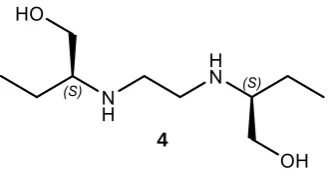
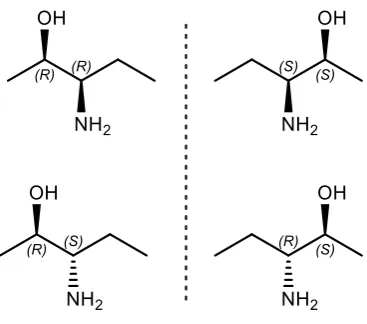
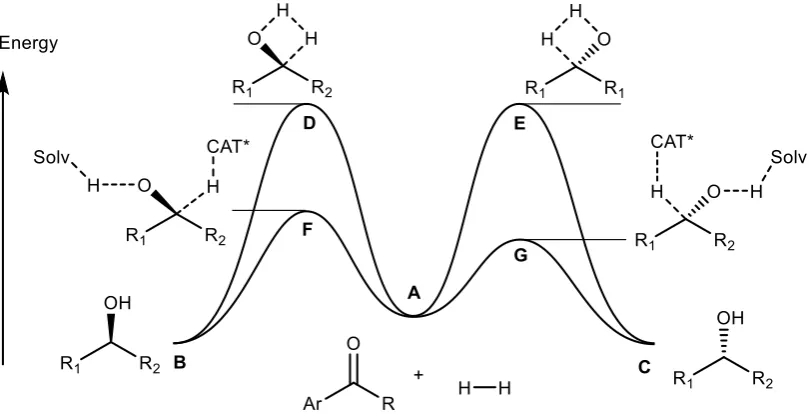
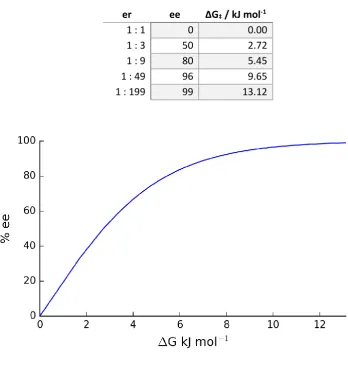
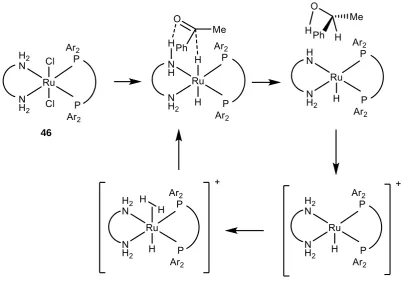
![Figure 10: [RuCl(arene)TsDPEN] precatalyst, commonly known as the Noyori catalyst.](https://thumb-us.123doks.com/thumbv2/123dok_us/9456463.452616/34.595.150.500.387.695/figure-rucl-arene-tsdpen-precatalyst-commonly-noyori-catalyst.webp)
